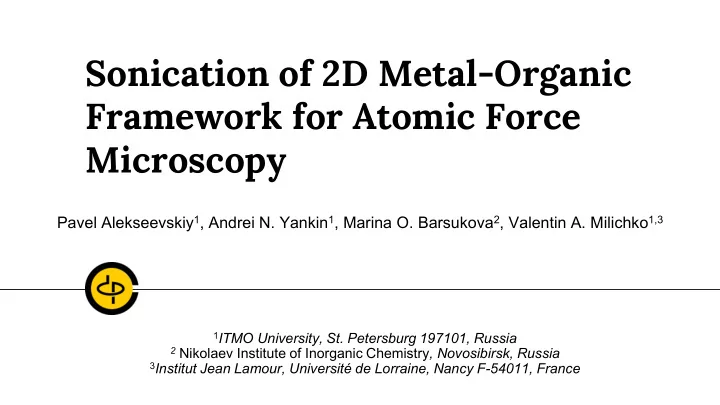

Sonication of 2D Metal-Organic Framework for Atomic Force Microscopy Pavel Alekseevskiy 1 , Andrei N. Yankin 1 , Marina O. Barsukova 2 , Valentin A. Milichko 1,3 1 ITMO University, St. Petersburg 197101, Russia 2 Nikolaev Institute of Inorganic Chemistry , Novosibirsk, Russia 3 Institut Jean Lamour, Université de Lorraine, Nancy F-54011, France
Introduction What if Bulk crystal of 2D MOF* is transformed into a nanosheet? *(MOF - metal−organic framework) Decreasing the size of MOFs to the nanometer scale is a fruitful approach to extend MOF applications 2
Working compound: MOF The main idea of our work is to exfoliate the nanosheets of 2D MOF via sonication process to study further the topology and mechanics by atomic force microscopy (AFM). As working sample the CSV 153 1 MOF was chosen. CSV 153: [Zn(ur)(abcd)]xDMFxH 2 O * ur – Urotropine abcd- AzoBenzeneDiCarboxylate* Reference: [1] Sapchenko, S.A., Barsukova, M.O., Nokhrina, T.V. et al. Urotropine as a ligand for the efficient 3 synthesis of metal-organic frameworks. Russ Chem Bull 69, 461–469 (2020).
Creation procedure There are two approaches to create MOF nanosheets Bottom - up Top - down Direct assembling Sonication, of MOF from metal freeze−thaw, ions and organic intercalation, and milling linkers processes 4
Sonication process as a chosen method Ultrasonic bath was used to implement the sonication process Working frequency:35 kHz Time range from 10 to 30 min Room temperature (24-25 ̊ C) Working solvent: DMF 5
Result of sonication: optical images o 10 minutes o 20 minutes o 30 minutes 6
Analysis of nanosheets: Raman To make sure that objects from previous slide are MOF’s nanosheets Raman spectra-analysis was done 7
Analysis of nanosheets: AFM The best option to study surface topology and roughness is atomic force microscopy (AFM) *All images in this slide and next ones are represented as the Magnitude signal of AFM tip. The use of such signal is more convenient to describe small objects.* 8
Analysis of nanosheets: AFM 9
Cleaning of nanosheets Dried solvent drops, Problem: solvent films After exfoliation procedure nanosheets are not always ready for AFM scanning 10
Cleaning of nanosheets Solution: Cleaned surface To clean and prepare the surface of MOF for scanning the corresponding procedure was developed : Solvent bath 11
Conclusions ◉ Well developed exfoliation procedure to layered MOF with contaminate-free surface ○ AFM scanning and Raman analysis as checking procedure were used ○ Solvent bath was introduced as additional step for surface cleaning Acknowledgements: M. Barsukova and Nikolaev Institute of Inorganic Chemistry for providing MOF sample. A . Yankin and V. Gilemkhanova for support in Chemistry field. 12
We are open for collaboration! Department of Physics Contacts ◉ pavel.alekseevskiy@metalab.ifmo.ru ◉ v.milichko@metalab.ifmo.ru 13
Recommend
More recommend